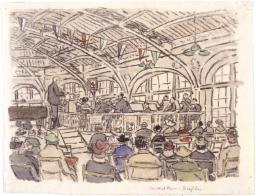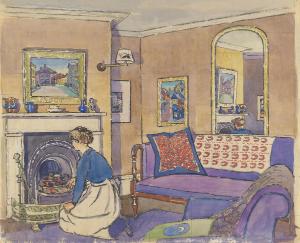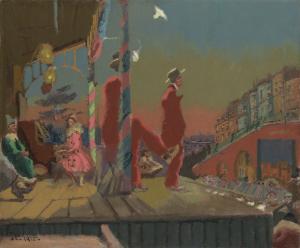Walter Richard Sickert The Front at Hove (Turpe Senex Miles Turpe Senilis Amor) 1930
Walter Richard Sickert,
The Front at Hove (Turpe Senex Miles Turpe Senilis Amor)
1930
This view looks towards Adelaide Crescent, a Regency townhouse development in the Brunswick area of Hove in Sussex. The residences were in decline from once-fashionable grandeur when the aging Walter Sickert encountered them, and as such resonate with the male figure seated on the bench chatting in earnest with the woman in red hat to his right. Containing an element perhaps of self-mockery, the painting’s Latin subtitle is a quotation taken from Ovid, ‘An old soldier is a wretched thing, so also is senile love’.
Walter Richard Sickert 1860–1942
The Front at Hove (Turpe Senex Miles Turpe Senilis Amor)
1930
Oil paint on canvas
635 x 762 mm
Inscribed by the artist ‘Sickert.30.’ in black paint bottom left
Purchased (Grant-in-Aid) 1932
N04651
1930
Oil paint on canvas
635 x 762 mm
Inscribed by the artist ‘Sickert.30.’ in black paint bottom left
Purchased (Grant-in-Aid) 1932
N04651
Ownership history
Lady Dawson of Penn; R.E.A. Wilson by 1931, by whom lent to French Gallery, London, where purchased for £500 by Tate Gallery July 1932.
Exhibition history
1931
An Anthology of English Painting 1900–1931, French Gallery, London, November 1931 (38).
1947–8
Contemporary British Paintings and Drawings, (British Council South African tour), Cape Town, Bloemfontein, Port Elizabeth, East London, December 1947–April 1948, Johannesburg, May–June 1948, Pretoria, July 1948, Durban, August–September 1948, Pietermaritzburg, October 1948 (unidentified venues, 95).
1966–77
Government Art Collection, October 1966, House of Commons, Ministry of Works, 1971–7 (long loan).
1981–2
Late Sickert: Paintings 1927–1942, (Arts Council tour), Hayward Gallery, London, November 1981–January 1982, Sainsbury Centre for the Visual Arts, University of East Anglia, Norwich, March–April 1982, Wolverhampton Art Gallery, April–May 1982 (3, reproduced).
1986
Sickert and Thanet: Paintings and Drawings by W.R. Sickert 1860–1942, Ramsgate Library Gallery, Kent, October–November 1986 (11).
1989–90
W.R. Sickert: Drawings and Paintings 1890–1942, Tate Gallery, Liverpool, March 1989–February 1990, Tate Gallery, London, July–September 1990 (33, reproduced).
1993
The Sussex Scene: Artists in the Twentieth Century, Towner Art Gallery, Eastbourne, July–August 1993, Hove Museum and Art Gallery, August–October 1993 (123, reproduced).
1995–6
Brighton Revealed Through Artists’ Eyes c.1760–c.1960, Brighton Museum and Art Gallery, November 1995–January 1996 (114, reproduced).
1998
Two British Impressionists: Walter Sickert and Philip Wilson Steer, Norwich Castle Museum, January–April 1998 (33, reproduced).
References
1931
Graphic, 5 December 1931, reproduced.
1943
Lillian Browse and R.H. Wilenski, Sickert, London 1943, pp.31, 63, reproduced pl.64.
1955
Anthony Bertram, Sickert, London and New York 1955, reproduced pl.45.
1960
Lillian Browse, Sickert, London 1960, p.102.
1964
Mary Chamot, Dennis Farr and Martin Butlin, Tate Gallery Catalogues: The Modern British Paintings, Drawings and Sculpture, vol.2, London 1964, p.625.
1973
Wendy Baron, Sickert, London and New York 1973, p.177, no.447.
1991
Simon Wilson, Tate Gallery: An Illustrated Companion, revised edn, London 1991, p.139.
1992
Wendy Baron and Richard Shone (eds.), Sickert: Paintings, exhibition catalogue, Royal Academy, London 1992, pp.298, 338.
2006
Wendy Baron, Sickert: Paintings and Drawings, New Haven and London 2006, pp.118, 529, no.701.
Technique and condition
The Front at Hove (Turpe Senex Miles Turpe Senilis Amor) is painted on an open-weave linen canvas attached with iron tacks to a four-membered stretcher. The canvas may be French but there is no identifying canvas stamp. The cloth is amply sized with glue and primed with an opaque white oil-based primer, which extends to the cut edges of the canvas and is smoothly and evenly applied, typical of pre-primed canvases from an artists’ colourman. The canvas, primer and most of the paint are so thin that the composition can be seen from the back through the canvas, although a layer of size has also been applied to the reverse, which increases the transparency.
Sickert has applied a thin pale blue camaieu with deeper blue shadows and pink lights (see also Tate N05089). The pink paint is composed of a mixture of lead white and a red pigment that is probably not a red earth, such as Indian red and more likely vermilion, red lake or a synthetic red.1 He has delineated the composition with this camaieu device, defining overall tone of his painting and leaving exposed camaieu for the shadow of an area such as the face of the male sitter. Sickert’s camaieu technique was based on the principle of working on well-dried paint. John Wheatley, one of the artist’s studio assistants, later described how Sickert devised a system of ensuring his works were dry before they were worked on again:
the painting was labelled and dated for three weeks subsequent to the date of the painting. It was hung on the studio walls, taking its place amongst the other pictures so hung in the order of their dates. Sickert or the studio assistant (according to whether the picture was in its final or preliminary stages) would enter the studio on any given morning and would take down the canvas bearing the correct date to be worked upon. If the passage to be completed did not fill in the whole of the working time the painting next in order of execution would be worked upon with strict adherence to precedence.2
The background and scene were painted first, quite thinly and economically, leaving much for the eye to complete. The figures in the foreground were painted last and are more thickly applied. The overall impression is one of a photograph with flat areas of colour and tone on the architecture and figures, the stylised foliage of the trees and sky and above all the washed-out highlights suggesting overexposure, although there is no known visual source material for this painting. There is drawing on top of the paint, which was probably made with a pastel or crayon rather than a charcoal stick.3 The drawing is applied on to the camaieu but also on top of the paint. Sickert appears to have made no effort to disguise his working methods and felt free to draw in lines with a dry medium.
The background paint is generally lean and applied dilute with little mixing on the canvas. There are small bubbles in the paint suggesting it was thoroughly mixed before application and there are many areas where the camaieu is visible and some where the white ground beneath is also visible. He has used a narrow range of colours mostly mixed with white, including a mixture of lead white and synthetic ultramarine for the mid-blue of the sky.4 The later applications of colour are more subdued using browns and greys premixed on a palette and are probably finished in a second campaign after a period to allow the background to dry. There are just a few pure white highlights, applied towards the end. The figures show some slight modification, for instance the far left figure, and a little more working on the canvas, but are painted in a characteristically Sickertian manner using a relatively large brush and more liquid paint, with just enough strokes to make the image work. The painting remains unvarnished.
Stephen Hackney
November 2004
Notes
How to cite
Stephen Hackney, 'Technique and Condition', November 2004, in Nicola Moorby, ‘The Front at Hove (Turpe Senex Miles Turpe Senilis Amor) 1930 by Walter Richard Sickert’, catalogue entry, August 2005, in Helena Bonett, Ysanne Holt, Jennifer Mundy (eds.), The Camden Town Group in Context, Tate Research Publication, May 2012, https://wwwEntry
In 1930 one newspaper reported ‘Sickert’s latest’:
Among those enjoying the benefit of this marvellous autumn at Brighton is Walter Sickert ... Sickert is in his seventieth year, but only yesterday I saw a beautiful picture he has painted, in his characteristic witty manner, of a couple sitting on a seat on the promenade.1
This painting, The Front at Hove (Turpe Senex Miles Turpe Senilis Amor), was the first landscape by Sickert to depict this part of the country since Brighton Pierrots (Tate T07041) fifteen years earlier. According to his friend and pupil Henry Rayner, it was painted from ‘old notes of the Brighton stay in 1926’.2
Forming personal connections with places was important to Sickert and integral to his success when painting landscapes. Certain territories enjoyed his favour at different moments throughout his lifetime: Dieppe and Envermeu, Venice, Camden Town and Islington, Bath and Bathampton, Chagford in Devon, and Thanet and Broadstairs in Kent. In 1926, shortly after marrying his third wife, Thérèse Lessore, he revisited one of his favoured haunts from previous years, spending the summer in Brighton.3 This sojourn by the seaside seems to have suited him so well that the following year he decided to return to find more permanent lodgings there. Sickert enjoyed the baths at Brighton and there were many old friends living nearby or visiting for a holiday themselves. London was accessible enough to make frequent journeys back to town if necessary. In May 1927 he took a studio in the Kemp Town area.4 He seems to have returned intermittently to Brighton over the next four years, only giving up the studio in 1931. It was probably during one of these trips that he painted The Front at Hove, a view looking towards the Regency townhouse development of Adelaide Crescent in the Brunswick area of Hove.
The painting shows the view standing on the promenade looking from the sea towards the Crescent. In the early nineteenth century Hove had been a fashionable area for wealthy holidaymakers who liked to stroll on the lawns along the front of Brunswick Terrace. Adelaide Crescent, named after Queen Adelaide who enjoyed visiting Brighton with her husband William IV, was built in 1830–4. The houses were large and particularly desirable since the curve of the façade of the Crescent afforded each property a view of the sea. In 1834 work on the development ground to a halt, however, after only ten houses had been built, possibly because Queen Victoria did not share her predecessors’ enthusiasm for the pleasures of Brighton and so the resort lost some of its fashionable appeal. Adelaide Crescent was not finally completed until the 1840s when the coming of the railway brought renewed investment to the area. In the 1930s, however, the area had somewhat lost its genteel associations and parts of it had fallen into a state of disrepair. Various plans for the redevelopment of the Crescent had been put forward and the dilapidated remnants of the earlier bygone era were in danger of vanishing forever.5 Such shabby grandeur no doubt appealed to Sickert who tended to be drawn to areas of former glory and declining fortune.
This sense of lost vitality is echoed within the theme of the painting, expressed by the group of figures seated on the bench in the left-hand foreground. On the right sits an elderly, bearded man in a brown suit and a bowler hat. Viewers familiar with Sickert’s appearance at this time would have recognised the element of self-portraiture in the figure. He sits with his legs crossed and his right arm resting on the back of the bench, facing towards a woman seated on the other half of the bench. She is muffled up in a dark brown coat and a red hat looking askance at the old man from under the brim of her hat. The dynamics of the interaction between these two figures is entirely expressed through their body language. The man leans in towards the woman. His deceptively casual pose belies what appears to be the predatory nature of his intentions and suggests the practised ease of an accomplished Lothario. She, by contrast, holds herself protectively and slightly draws away while looking warily aside at him making it clear that his advances are unwelcome. The pictorial space between these two is occupied by a third figure, a man in a top hat and coat. He sits on the other side of the bench with his back to the viewer, completely oblivious to the exchange taking place behind him. Sickert made the interpretation of the episode explicit by appending a Latin quotation taken from Ovid’s Amores to the painting’s title: ‘Turpe senex miles turpe senilis amor’ (An old soldier is a wretched thing, so also is senile love).6 As someone who had always been flirtatious and something of a success with women, Sickert is making a witty but self-mocking comment on the experience of growing old. He himself had remarried in 1926 to the painter Thérèse Lessore who may have been the female model for the picture.7 The faded elegance of the architecture occupying the right-hand side of the painting is a fitting counterpoint to the slightly pathetic sight of the elderly flatterer to the left. Both are now past their prime.
The style of The Front at Hove is characteristic of Sickert’s painting at this time in the use of an underpainted ground mapping out the tonal contrasts of the scene. Since about 1915 Sickert had advocated preparing a canvas with a suitable colour mixed with white in varying degrees of depth. The composition of the picture was then blocked in with the lowest tones and areas of shadow completed first, then the half tones, and finally the lights. These tones were relative to one another within a narrow range and, according to Sickert, ‘the picture at this stage should present the same appearance as if one were looking at a landscape in a mist’.8 When the ground was completely dry any additional, local colouring was then added. The chosen ground for The Front at Hove consists of two colours: a light blue used in conjunction with some pink. The art historian Richard Shone has noted that this was a favourite combination apparent in a number of other paintings of the period, for example The Plaza Tiller Girls 1928 (private collection).9 The art historian Wendy Baron has also observed the similarity of the ‘light tonality and clear chalky colouring, and the scumbled handling of the dry paint’ to the distinctive style of the series of paintings known as the ‘Echoes’ (see Tate T05529).10 The predominance of unbroken blue sky and the bleached colouring of the background are particularly reminiscent of Summer Lightning c.1931–2 (Walker Art Gallery, Liverpool).11 Any corresponding visual associated material for The Front at Hove is unknown, but by this stage Sickert was most frequently deriving images for works from photographic sources.
The painting was purchased by the Tate Gallery from the dealer R.E.A. Wilson for £500, ‘an exceptionally low price for such a picture’.12 Wilson later wrote to the Tate’s director, James Bolivar Manson, conveying Sickert’s anxiety regarding the cataloguing of the work as The Front at Hove:
I am being constantly blown up by Sickert for having sold a picture under a wrong title. He does not like the name “The Front at Hove” & is very anxious to have the picture shown under its real name which is:– TURPE SENEX MILES TURPE SENILIS AMOR. Would it be possible to have the tabler attend to this? It would delight Sickert if you would do so.13
Sickert himself also made a point of correcting the title in a letter to the Daily Mirror where he condemned the oversight. ‘If our curators are going to rechristen our paintings,’ he wrote, ‘they will probably end by repainting them.’14
Nicola Moorby
August 2005
Notes
‘Sickert’s Latest’, ?1930, source unknown, Walter Sickert press cuttings, Islington Public Libraries, London.
Ovid, Amores, I, ix, line 4; quoted in Mary Chamot, Dennis Farr and Martin Butlin, Tate Gallery Catalogues: The Modern British Paintings, Drawings and Sculpture, vol.2, London 1964, p.625.
Wendy Baron and Richard Shone (eds.), Sickert: Paintings, exhibition catalogue, Royal Academy, London 1992, p.298.
Related biographies
Related catalogue entries
How to cite
Nicola Moorby, ‘The Front at Hove (Turpe Senex Miles Turpe Senilis Amor) 1930 by Walter Richard Sickert’, catalogue entry, August 2005, in Helena Bonett, Ysanne Holt, Jennifer Mundy (eds.), The Camden Town Group in Context, Tate Research Publication, May 2012, https://www





